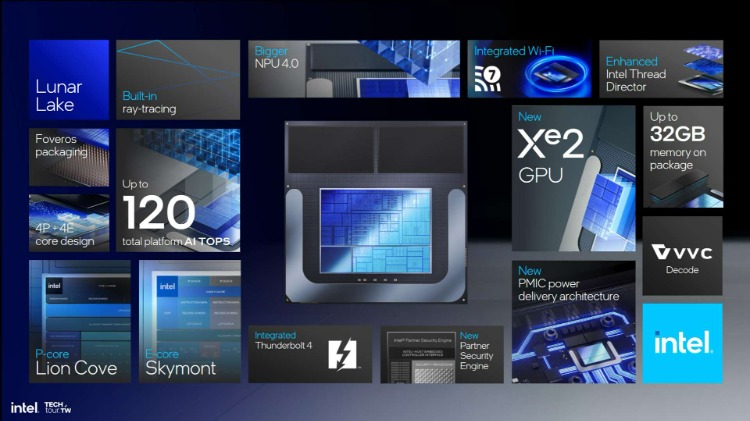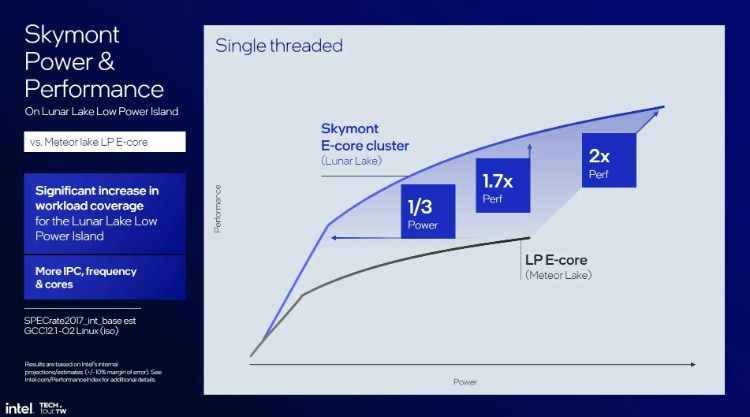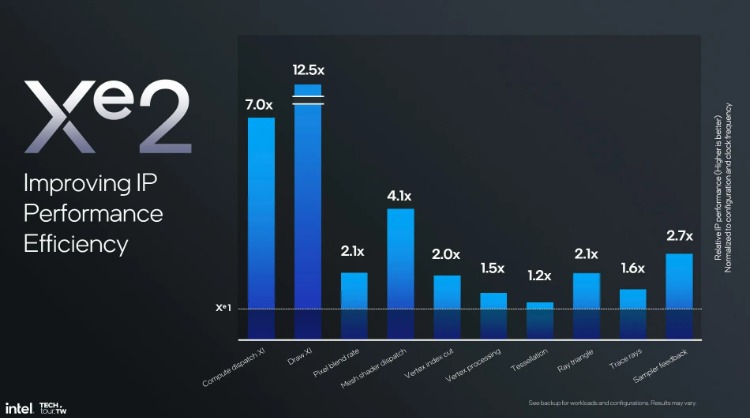As the tech world buzzes with anticipation for Intel's next-generation Arrow Lake processors, another significant advancement in the pipeline is Intel's Lunar Lake, a mobile-first architectural marvel. This innovative design promises to redefine efficiency and performance standards in mobile computing, marking one of Intel's most thrilling product launches in years.
Lunar Lake Specifications
Intel unveiled Lunar Lake's architecture and design details in May 2024, highlighting its focus on efficiency. At Computex 2024, further revelations showed that Lunar Lake processors could achieve a 30% reduction in power draw while maintaining competitive performance levels. Central to this achievement is the new Skymont architecture, which powers the efficiency (E) cores responsible for handling most of the workload.
Lunar Lake features a mix of four Lion Cove performance (P) cores and four Skymont E cores. These configurations are scalable, though specific models are yet to be announced. Each chip will also include a new neural processor capable of 48 trillion operations per second (TOPS), four times the capacity of Meteor Lake’s neural processor, significantly enhancing AI performance.
 source: intel
source: intel
Graphics performance gets a boost with integrated Xe2 graphics, designed for gaming and capable of delivering up to 60 TOPS. These GPUs are expected to eventually power Intel’s Battlemage graphics cards but for now, provide impressive performance for casual gaming, potentially eliminating the need for entry-level GPUs. This leap is attributed to native support for the ExecuteIndirect command common in DX12 games, new compression techniques, and faster cache clearing for overall efficiency.
Lunar Lake drops hyper-threading, opting instead for a TSMC N3 processor for the compute tile and the N6 node for the platform tile. This decision marks a departure from Intel's in-house fabrication, as it gears up to leapfrog to the 18A node.
In terms of features, Lunar Lake supports PCI-Express 5, Thunderbolt 4, USB4, HDMI 2.1, DisplayPort 2.1, Wi-Fi 7, Bluetooth 5.4, and Gigabit Ethernet. The chips will also support up to 32GB of LPDDR5X memory for enhanced performance.
Availability of Lunar Lake
Lunar Lake is slated for an end-of-2024 release alongside Arrow Lake for desktops. Although no specific models have been announced, Intel has demonstrated working silicon at trade shows, suggesting a feasible timeline. Initially, availability might be limited, ramping up to mass production in early 2025.
Performance and Efficiency
Lunar Lake represents Intel's first complete architectural overhaul in generations, leveraging Foveros technology for a mix of performance and efficiency cores. The new design promises up to 1.5 times the performance of Meteor Lake processors with similar power consumption. Computex 2024 showcased over a 50% performance-per-watt improvement in Lion Cove P cores and a 20-80% generational improvement in Skymont E cores. Compared to Meteor Lake E cores, Skymont can deliver double the performance or match Meteor Lake’s performance at a third of the power, enhancing battery life significantly.
 source: intel
source: intel
The E cores in Lunar Lake are particularly noteworthy. They provide more performance per clock than previous P cores, thanks to added cache, a new process node, and architectural enhancements. This improvement allows the new Skymont E cores to outperform Raptor Cove P cores by 2% in instructions per clock.
AI performance is another highlight, with the redesigned neural processor handling up to 45 TOPS, competitive with Snapdragon X Elite’s NPU. Combined with the Xe2 GPU’s 60 TOPS, Lunar Lake chips achieve over 100 TOPS in total, driving local AI capabilities to new heights.
 source: intel
source: intel
Design Innovations
Lunar Lake introduces several design changes aimed at boosting efficiency and performance. By integrating 16 or 32GB of LPDDR5X memory into the package itself, the system reduces power consumption for data transfer by 40%. This integrated memory approach also means that Lunar Lake laptops won't have separate memory sticks or chips.
 source: intel
source: intel
Moreover, Lunar Lake supports native H.266 VVC video for better file size reduction without compromising quality. It incorporates Wi-Fi 7 and Bluetooth 5.4, promising 55% faster wake-up times for wireless connections. The new Partner Security Engine, akin to Microsoft Pluton, adds a layer of security with its dedicated processor, fuse, and crypto portion.
In the realm of graphics, Lunar Lake’s Xe2 GPU stands out with a 1.5x performance increase over Meteor Lake, which was already twice as powerful as its predecessor. This performance gain comes from a combination of efficiency improvements and enhanced functionality, ensuring robust graphics capabilities across various laptop models. The Xe2 GPU also brings 67 TOPS of AI performance, complementing the tripled NPU hardware for enhanced AI tasks.
Intel’s commitment to AI is evident as Lunar Lake triples the NPU hardware on the die, doubles memory bandwidth, and boosts clock speed. This enhancement results in up to 48 TOPS of AI acceleration, and significantly faster processing times for tasks like Stable Diffusion while maintaining reasonable power consumption.
Intel aims to launch a significant wave of Lunar Lake laptops later this year, with designs from over 20 hardware partners. Despite the competitive landscape, especially with Qualcomm’s rising prominence in AI PCs, Intel is confident in Lunar Lake’s ability to deliver exceptional user experiences.



